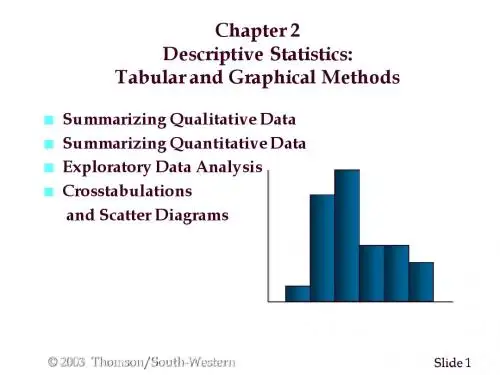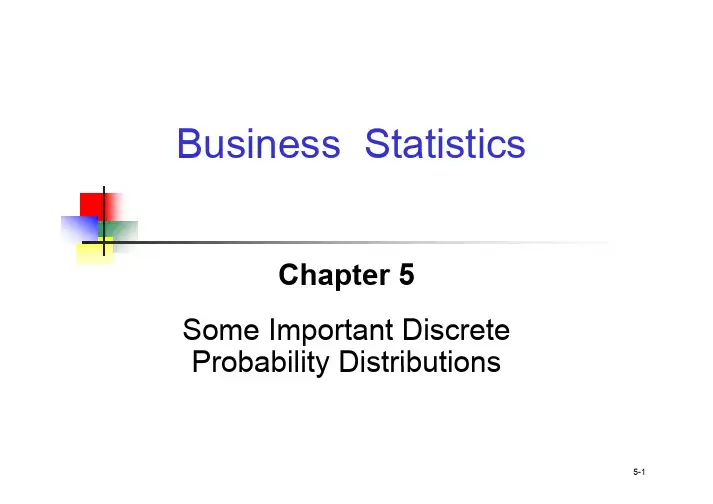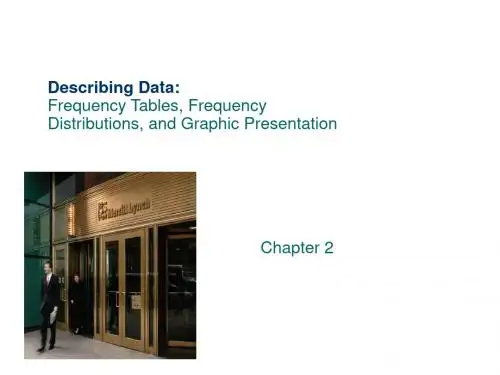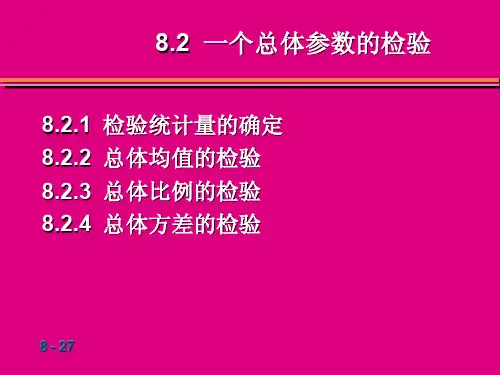描述统计学chap02
- 格式:ppt
- 大小:3.33 MB
- 文档页数:85





Business Statistics B siness StatisticsChapter 5Some Important Discrete Probability Distributions Probability DistributionsChapter GoalsChapter GoalsAfter completing this chapter, you should be Aft l ti thi h t h ld b able to:Interpret the mean and standard deviation for a I t t th d t d d d i ti f discrete probability distributionExplain covariance and its application in finance E l i i d it li ti i fiUse the binomial probability distribution to find probabilitiesb bilitiDescribe when to apply the binomial distribution Use Poisson discrete probability distributions to find probabilitiesDefinitionsRandom VariablesRandom VariablesA random variable represents a possible numerical value from an uncertain event. numerical value from an uncertain event.Discrete random variables produce outcomes random variables produce outcomes that come from a counting process (e.g. number of courses you are taking this semester).of courses you are taking this semester).random variables produce Continuous random variables produce outcomes that come from a measurement (e.g. your annual salary, or your weight).your annual salary,or your weight).R d V Definitions i blRandom Variables RandomVariablesC Discrete ContinuousRandom Variable Random Variable Ch. 5Ch. 6Can only assume a countable number of values CProbability Distribution for aDiscrete Random VariableDiscrete Random VariableA probability distribution (or probability mass function )(pdf) A b bilit di t ib ti(b bilit f ti)(df for a discrete random variable is a mutually exclusive listing of all possible numerical outcomes for that random variable of all possible numerical outcomes for that random variable such that a particular probability of occurrence is associated with each outcome.Number of Classes ProbabilityTaken20.230.40440.2450.16016Experiment: Toss 2 Coins. Let X = # heads.4 possible outcomes4possibleS MSummary MeasuresE t d V l()f di tExpected Value (or mean)of a discrete distribution (Weighted Average)∑===µN1iii)X(PXE(X)E l T2iX P(X) Example:Toss 2 coins,X= # of heads,t t d l f X0 .251 .50compute expected value of X:E(X) = (0 x .25) + (1 x .50) + (2 x .25)=102 .25= 1.0(continued) Variance(continued)σThe Covariance The CovarianceThe covariance measures the strength of thelinear relationship between two variables ea e a o s p be ee o a ab es The covariance :)Y X (P )]Y (E Y )][(X (E X [σNi i i i XY ∑−−=1i =where:X = discrete variable X=the i th outcome of X X i = the i outcome of X Y = discrete variable Y Y i = the i th outcome of Y )=probability of occurrence of the condition affectingP(X i Y i ) probability of occurrence of the condition affecting the i th outcome of X and the i th outcome of YComputing the Mean for I RInvestment Returns Return per $1,000 for two types of investmentsP(X i Y i )Economic condition Passive Fund XAggressive Fund YInvestment.2Recession -$ 25-$200.5Stable Economy + 50+ 60.3Expanding Economy+ 100+ 350E(X) = µX = (-25)(.2) +(50)(.5) + (100)(.3) = 50E(Y)(200)(2)(60)(5)(350)(3)95E(Y) = µY = (-200)(.2) +(60)(.5) + (350)(.3) = 95Computing the Standard DeviationP(X.2.5.3Computing the Covariance f I Rfor Investment Returns P(X i Y i )Economic condition Passive Fund XAggressive Fund YInvestment.2Recession -$ 25-$200.5Stable Economy + 50+ 60.3Expanding Economy+ 100+ 35095)(.5)50)(60(5095)(.2)200-50)((-25σY X ,−−−−+−−=825095)(.3)50)(350(100=+Interpreting the Results forI RInvestment ReturnsThe aggressive fund has a higher expectedreturn,but much more risk return, but much more risk=95>µ=50µY = 95 > µX = 50but19321>4330σY = 193.21 > σX = 43.30 The Covariance of 8250 indicates that the twoinvestments are positively related and will vary in the same direction in the same directionPortfolio ExamplePortfolio ExampleReturnsProbability Stock X Stock Y0.1-$100$5001$1000.301500.380-200.3150-100You are trying to develop a strategy for investing in two different stocks. The anticipated annual return for a different stocks The anticipated annual return for a $1,000 investment in each stock has the above probability distributions.probability distributions.Compute the1) Expected return for stock X2) Expected return for stock Y3) Standard deviation for stock X3)Standard deviation for stock X4) Standard deviation for stock Y5) Covariance of stock X and stock Y5)C i f t k X d t k Y6) Do you think you will invest in stock X or stock Y?Explain.Suppose you wanted to create a portfolio that consists of stock X and stock Y. Compare the portfolio expected return and portfolio risk for each of the following proportions invested in stock X:7) 0.1 8) 0.77)018)079)0.3 10) 0.9 11) 0.5On the basis of the results of 7)—11), which portfolio would you recommend? Explain.Probability Distributions Probability Distributions Probability Distributions Continuous Probability Discrete Probability Ch. 5Ch. 6ProbabilityDistributionsProbability Distributions Binomial NormalHypergeometric UniformPoisson ExponentialBinomial Probability Distribution Binomial Probability DistributionA fixed number of observations n A fixed number of observations, ne.g., 15 tosses of a coin; ten light bulbs taken from a warehouse Each observation is categorized as to whether or not the g“event of interest” occurrede.g., head or tail in each toss of a coin; defective or not defective light b lb bulb Since these two categories are mutually exclusive and collectively exhaustive(Generally called “success ” and “failure ”) When the probability of the event of interest is represented as π, then the probability of the event of interest not occurring is 1 -πConstant probability for the event of interest occurring ()for Constant probability for the event of interest occurring (π) for each observationProbability of getting a tail is the same each time we toss the coin y g gBinomial Probability Distribution Binomial Probability Distribution(continued)Observations are independentThe outcome of one observation does not affect theoutcome of the otherp g pTwo sampling methods deliver independenceInfinite population without replacementFinite population with replacementPossible Applications for theppBinomial DistributionA manufacturing plant labels items as either defective or acceptableeither defective or acceptableA firm bidding for contracts will either get a contract or notA marketing research firm receives survey A marketing research firm receives survey responses of “yes I will buy” or “no I will not” New job applicants either accept the offer Ne job applicants either accept the offer or reject itThe Binomial DistributionCounting TechniquesCounting TechniquesSuppose the event of interest is obtaining heads on the toss of a fair coin.You are to toss the coin three times. toss of a fair coin. You are to toss the coin three times. In how many ways can you get two heads?Possible ways: HHT, HTH, THH, so there are threeP ibl HHT HTH THH th thways you can getting two heads.This situation is fairly simple. We need to be able to count the number of ways for more complicated situations.31Binomial Distribution Formula Binomial Distribution FormulaP(X)n X !π(1-π)X n X !=−P(X)=probability of events of interest in X !n X ()!−P(X) = probability of X events of interest in ntrials, with the probability of an “event ofinterest” being πfor each trialExample:Flip a coin four times, let x = # heads:X = number of “events of interest” in sample, (X = 0, 1, 2, ..., n )l i (b f t i l,n = 4π= 0.5n = sample size (number of trials or observations)π= probability of “event of interest” 1 -π= (1 -0.5) = 0.5X = 0, 1, 2, 3, 4p yThe Binomial Distribution E Example lSuppose the probability of purchasing a defective computer p is 0.02. What is the probability p y of purchasing 2 defective computers in a group of 10? X = 2, n = 10, and π = .02n! P(X = 2) = π X (1 − π ) n − X X!(n − X)! 10! = (.02) 2 (1 − .02)10 − 2 2!(10 − 2)! = (45)(.0004)(.8508) = .015315-31Example Suppose that 20% of all copies of a particular textbook fail a certain binding strength test test. Let X denote the number among 15 randomly selected copies that fail the test test. Find the probability that at most 8 fail the test Find the probability that exactly 8 fail the test Find the probability that at least 8 fail the test5-32The Binomial Distribution Shape The shape of the bi binomial i l di distribution t ib ti depends on the values of π and n Here, n = 5 and π = .1P(X) .6 .4 .2 0 0 P(X) .6 .4 .2 0 0 1 2 3 4 5 X5-33n = 5 π = 0.112345Xn = 5 π = 0.5Here, , n = 5 and π = .5The Binomial Distribution Using Binomial Tablesn = 10 x 0 1 2 3 4 5 6 7 8 9 10 … … … … … … … … … … … … … π=.20 0.1074 0 2684 0.2684 0.3020 0.2013 0.0881 0 0264 0.0264 0.0055 0.0008 0.0001 0 0000 0.0000 0.0000 π=.80 π=.25 0.0563 0 1877 0.1877 0.2816 0.2503 0.1460 0 0584 0.0584 0.0162 0.0031 0.0004 0 0000 0.0000 0.0000 π=.75 π=.30 0.0282 0 1211 0.1211 0.2335 0.2668 0.2001 0 1029 0.1029 0.0368 0.0090 0.0014 0 0001 0.0001 0.0000 π=.70 π=.35 0.0135 0 0725 0.0725 0.1757 0.2522 0.2377 0 1536 0.1536 0.0689 0.0212 0.0043 0 0005 0.0005 0.0000 π=.65 π=.40 0.0060 0 0403 0.0403 0.1209 0.2150 0.2508 0 2007 0.2007 0.1115 0.0425 0.0106 0 0016 0.0016 0.0001 π=.60 π=.45 0.0025 0 0207 0.0207 0.0763 0.1665 0.2384 0 2340 0.2340 0.1596 0.0746 0.0229 0 0042 0.0042 0.0003 π=.55 π=.50 0.0010 0 0098 0.0098 0.0439 0.1172 0.2051 0 2461 0.2461 0.2051 0.1172 0.0439 0 0098 0.0098 0.0010 π=.50 10 9 8 7 6 5 4 3 2 1 0 xExamples:n = 10, π = .35, x = 3: n = 10, π = .75, x = 2: P(x = 3|n =10, π = .35) = .2522 P(x = 2|n =10, π = .75) = .00045-34Binomial Distribution Ch Characteristics t i ti Meanµ = E(x) ( ) = nπσ = nπ ( (1 - π )σ = nπ ( (1 - π )2Variance and Standard DeviationWheren = sample size π = probability of the event of interest for any trial (1 – π) = probability of no event of interest for any trial5-35The Binomial Distribution CharacteristicsExamplesµ = nπ = (5)(.1) (5)( 1) = 0.5 05σ = nπ (1 - π ) = (5)(.1)(1 − .1) = 0.6708P(X) .6 .4 .2 0 0 P(X) .6 .4 .2 0 0 1 1n = 5 π = 0.12345Xµ = nπ = (5)(.5) = 2.5σ = nπ (1 - π ) = (5)(.5)(1 − .5) = 1.118 1 118n = 5 π = 0.52345X5-36Using Excel For The Binomial Distribution5-37Using PHStat Select PHStat / Probability & Prob. Distributions / Binomial…5-38Using PHStat(continued) Enter desired values in dialog box Here: n = 10 π = .35 Output for X = 0 to X = 10 will be generated by PHStat Optional check boxes for additional output5-39PHStat OutputP(X = 3 | n = 10, π = .35) = .2522P(X > 5 | n = 10, 10 π = .35) 35) = .0949 09495-40=Binomdist (numbers_s, trials,probability_s, cumulative)b bilit l ti)The Hypergeometric Distribution The Hypergeometric Distribution“n” trials in a sample taken from a finiteof size Npopulation of size NSample taken without replacementOutcomes of trials are dependentConcerned ith finding the probabilit of“X”Concerned with finding the probability of “X” successes in the sample where there are “A” successes in the population■Example:ExampleFive individuals from an animal population thought to be near extinction in a certain region thought to be near extinction in a certain regionhave been caught, tagged, and released tomixed into the population. After they have hadp p yan opportunity to mix, a random sample of 10 ofthese animals is selected . Let X be the numberof tagged animals in the second sample. If theref t d i l i th d l If thare actually 25 animals of this type in the region,what is the probability thatwhat is the probability that1) X=2?2) X2?2)X≤Hypergeometric Distributionin PHStati PHSSelect:PHStat / Probability & Prob. Distributions / Hypergeometric …Hypergeometric Distributionin PHStati PHSt t(continued)Complete dialog box entries and get output…N 10n 3N=10n=3A = 4X = 2P(X = 2) = 0.3The Poisson DistributionThe Poisson DistributionApply the Poisson Distribution when:You wish to count the number of times an event occurs in a given area of opportunityThe probability that an event occurs in one area of t it i th f ll f t it opportunity is the same for all areas of opportunity The number of events that occur in one area of opportunity is independent of the number of events opportunity is independent of the number of events that occur in the other areas of opportunityThe probability that two or more events occur in an The probability that two or more events occur in an area of opportunity approaches zero as the area of opportunity becomes smallerThe average number of events per unit is λ(lambda)。





